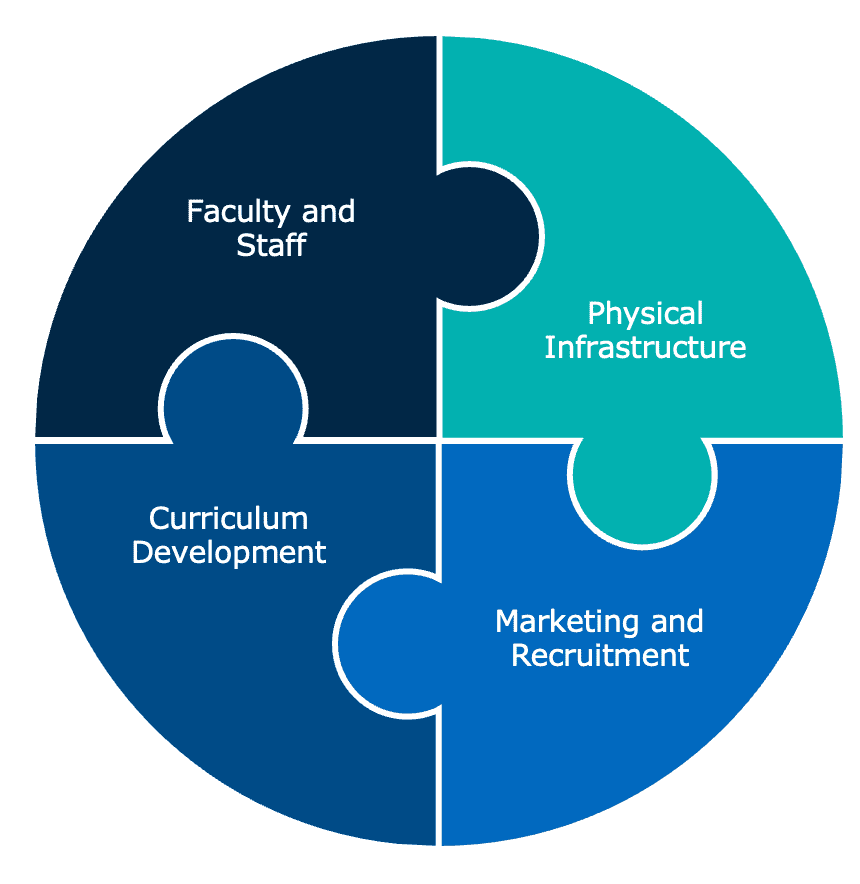Struggling to price your graduate program? Here are the four factors you need to consider.
If you feel like you don’t know where to start when it comes to pricing your graduate program, you are not alone. Throughout my conversations supporting EAB’s Adult Learner Recruitment partners, this is one of the most asked questions. What works for one program may not work for another, and truthfully, most teams don’t have a consistent methodology for pricing. As a former VPEM, I wrestled with questions like this all the time, especially as it related to providing educational access to underserved students. Here is what I wish I knew.
Four Factors to Consider When Pricing Your Graduate Program
1. Program Costs
One of the top considerations for pricing your program is how much it costs to run. For most programs, this includes (but is not limited to) the cost of faculty and staff, physical infrastructure, marketing and recruitment, and curriculum development.
 Cost Components:
Cost Components:
Faculty and Staff, including salaries and benefits for all program personnel, including faculty, staff, advisors, counselors, etc. You may also need to consider that for certain program types, a smaller student to faculty ratio might be necessary.
Physical Infrastructure, including classroom and lab space, equipment and technology, clinical placements, and student and commuter spaces.
Marketing and Recruitment, including lead generation resources, digital marketing, and market research. Keep in mind that for smaller and more niche programs, additional resources may be necessary to meet enrollment goals.
Curriculum Development, including an instructional designer to develop the course, as well as resources to refresh and modify the course as needed (every ~18 months is a good standard).
2. Program Outcomes
How much can graduates of your program expect to earn one year out? What about five years? Ten years? What percentage of graduates are employed? How long does it take on average for graduates to find jobs? These are just a few of the questions you should be asking yourself when pricing your program. In a recent survey of graduate and adult learners, we learned that the characteristic they consider to best represent the value of education is successful job placement upon graduation. Make sure you price your program relative to program outcomes, because if your graduates won’t make their money back, they won’t enroll.
3. Competitor Pricing
When developing programs, comparing your program to your competitors should be a regular practice, and this is especially true as it relates to pricing. If your program is priced higher than your competitors’, you’ll need to ensure that you have reasons to justify it. If your program is priced lower than your competitors, it could provide you with a competitive edge.
I recently completed a competitive intelligence report for an Adult Learner Recruitment partner comparing their Master of Education program to five of their top competitors. I found that in 2017 and 2018, they were the top Master of Education provider in the state, but by 2021, their conferrals declined by the same rate that a competitor program grew, thus surpassing them and becoming the largest provider. The biggest difference? Their competitor was pricing their program 25% lower in total cost.
4. Price Sensitivity of Prospects
In our recent survey, we found that nearly half of surveyed adult learners said they are unwilling to spend more than $15,000 annually to finance their education, including loans and personal financial resources.
-
49.5%
of surveyed students are willing to spend no more than $15,000 annually on their education
Consider the type of student you are hoping to attract to your program and how much they might be able to afford. For example, if the program is marketed towards prospects who do not have an established career, they may not be able to pay as much for another degree as a prospect that is further along in their career and already has an advanced certificate/degree. Students may also be more or less willing to pay based on their learning goals and objectives.
In addition to the price sensitivity of your prospects based on those factors, also consider the level of financial aid and scholarships you are willing and expecting to provide, and how that will factor into their decision-making process.
Regardless of where you land on price, being transparent is paramount. When it comes to tuition, there shouldn’t be any hidden fees. After considering all of these variables and making a thoughtful decision on your pricing, I hope that you’ll feel more empowered to clearly and prominently display total costs, total time to completion, and outcome information on your program website and marketing materials.

More Blogs

The higher ed SEO checklist

Are you recalibrating your graduate and adult recruitment strategy?
